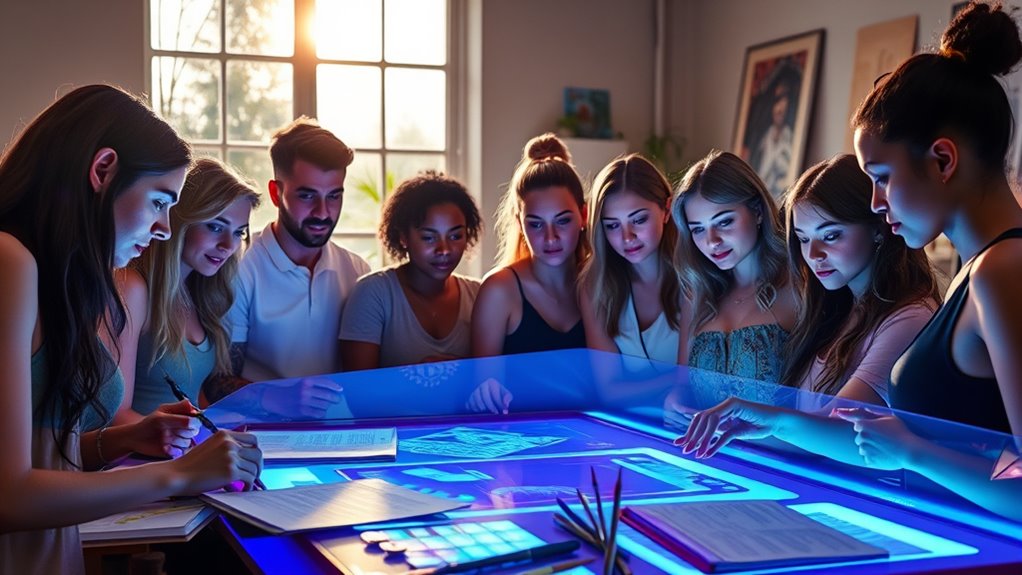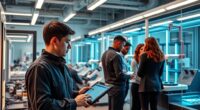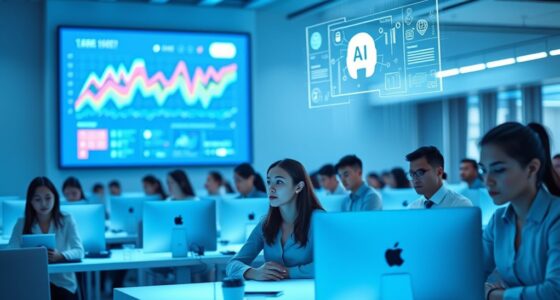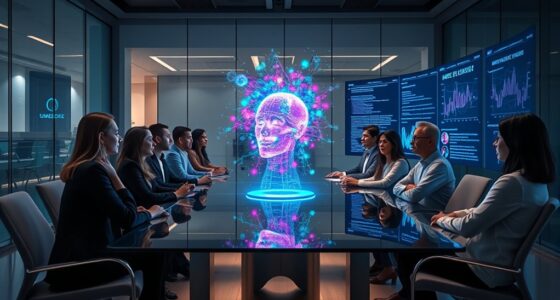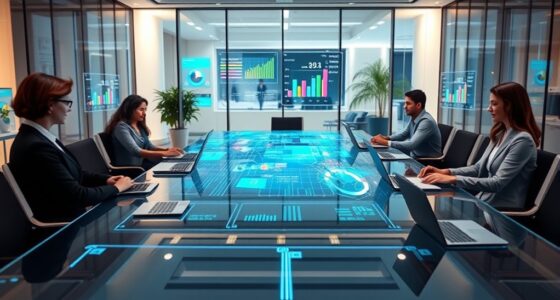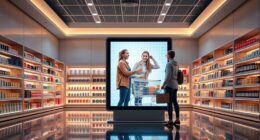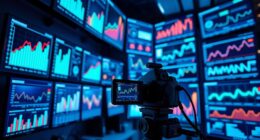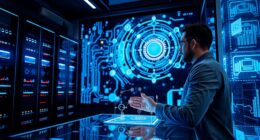You’re seeing how artists and writers are increasingly using AI as a creative partner to expand their possibilities. AI tools help generate ideas, streamline workflows, and inspire new forms of expression, allowing you to focus on your unique vision. This collaboration challenges traditional notions of authorship and originality while boosting productivity. As AI continues to evolve, it’s shaping a future where human creativity and machine assistance work hand in hand—exploring opportunities you won’t want to miss.
Key Takeaways
- Artists and writers collaborate with AI to co-create, blending human intent with machine-generated outputs for innovative artistic expressions.
- AI tools streamline workflows, automate routine tasks, and inspire rapid iteration, enhancing productivity in creative processes.
- Human strengths like originality, ethics, and emotional depth complement AI’s pattern recognition and data analysis capabilities.
- Ethical considerations, including authorship, copyright, and sustainability, shape responsible AI integration in creative fields.
- The partnership democratizes creation, making professional-quality work accessible and fostering new artistic and literary possibilities.
Embracing AI for Artistic Autonomy and Innovation
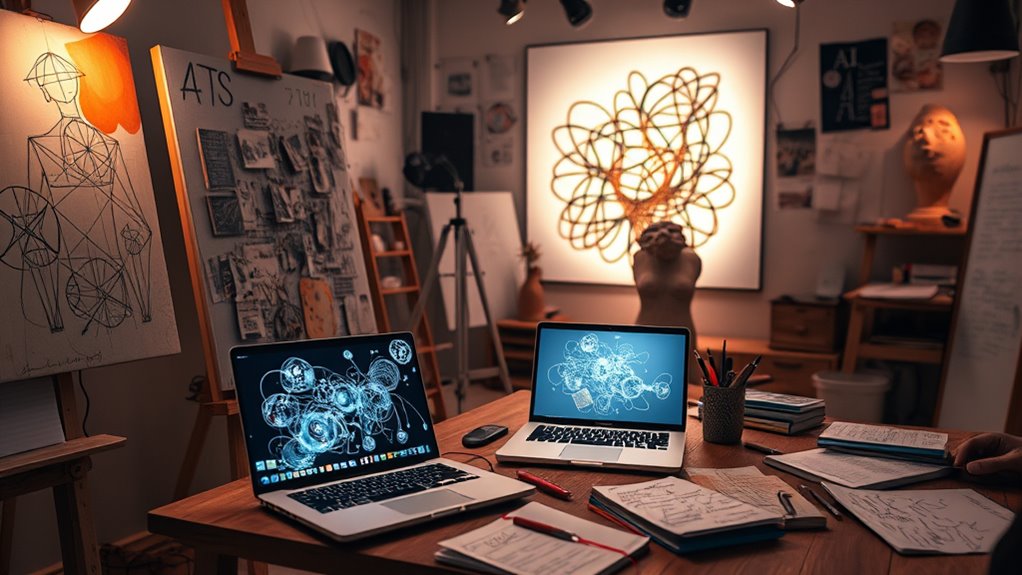
Embracing AI in art opens new horizons for creativity and innovation, empowering you to take greater control over your work. Over 92% of artists report feeling they influence the artwork when using text-to-image tools, highlighting how AI can enhance your creative input. Tools like DARCI foster co-creative processes by giving both human and machine intentionality, leading to hybrid art forms that blend algorithms with artistic vision. While AI produces derivative outputs based on trained images, it also offers surprising results by integrating your human intent. Ethical considerations emphasize preserving your autonomy, ensuring AI acts as a facilitator rather than a replacement. Transparency in affiliate marketing strengthens your brand identity and builds trust with your audience. Additionally, understanding software quality assurance principles can help you better evaluate and select AI tools that meet your creative standards. Incorporating natural materials like linen and reclaimed wood can further amplify your artistic expression within the AI-driven creative process. Recognizing regional resources and tools can also provide valuable insights into emerging trends and opportunities in AI-assisted art. Ultimately, AI expands your creative possibilities, enabling you to explore new styles, push boundaries, and reinvent artistic expression with greater confidence and control. AI in art market is projected to reach over $0.9 billion by 2030, providing abundant opportunities for innovation and growth.
Transforming the Writing Landscape With Artificial Intelligence
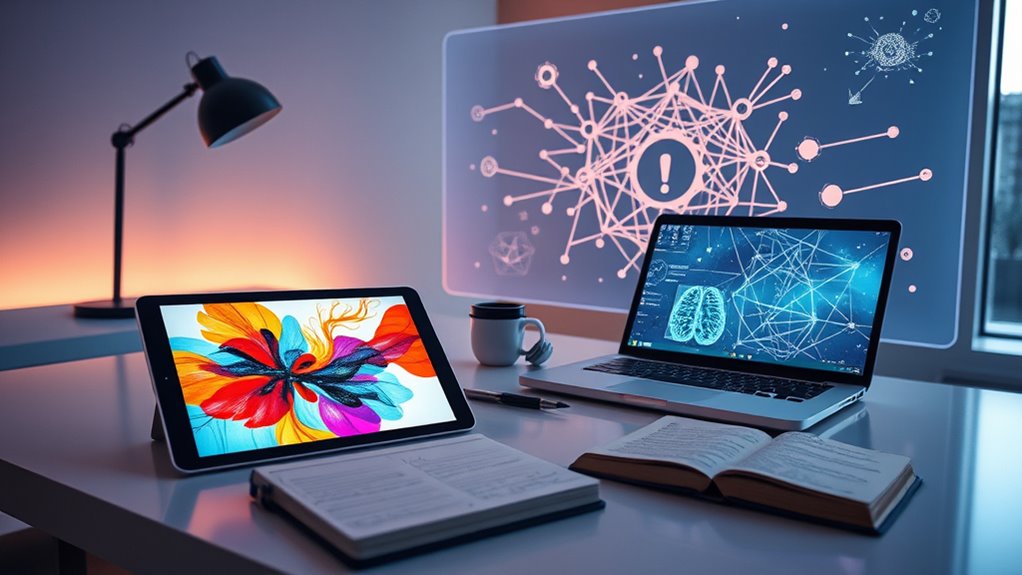
Artificial intelligence is revolutionizing how we create and share written content, making the process faster, more efficient, and increasingly innovative. Nearly half of organizations now use AI or machine learning for various tasks, with 58% of those leveraging generative AI specifically for content creation. As a result, bloggers save about 30% of their writing time, boosting productivity. The global AI market, valued at nearly $197 billion in 2024, continues to grow rapidly, creating new opportunities and roles. AI automates routine tasks, improves accuracy, and enables writers to focus on creative aspects. While some jobs may be displaced, AI also opens doors to new careers in content strategy and AI development. This ongoing transformation is reshaping the entire writing landscape, propelling it toward a more dynamic future. AI’s expanding influence is evident across industries, further accelerating content creation innovation. Additionally, the integration of AI with appliance maintenance plans showcases how technology streamlines operational tasks and enhances efficiency beyond content creation.
AI-Driven Music Creation and Industry Evolution
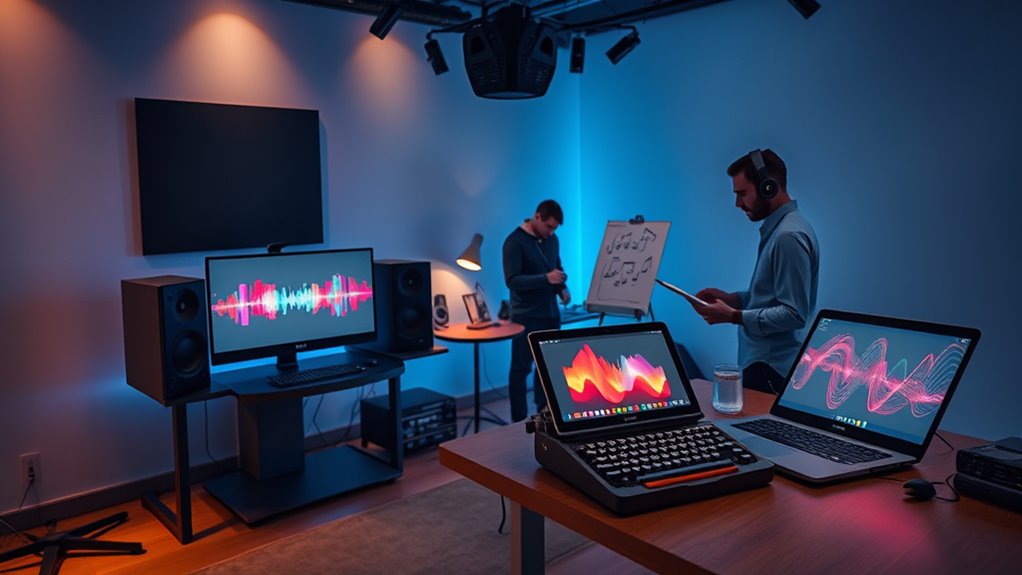
AI-driven tools are transforming how music is created, enabling artists and producers to compose, remix, and experiment more quickly and creatively than ever before. With text-to-music generation, you can turn ideas into soundtracks effortlessly, while stem separation allows for precise remixing by isolating individual elements. Lyrics generation offers fresh inspiration, helping you craft words that match specific themes or moods. Composition assistance speeds up creating melodies and harmonies, and style transfer enables you to explore different genres easily. The industry is expanding rapidly; the AI music market is projected to hit $38.7 billion by 2033, boosting revenues substantially. By 2025, around 60% of musicians will incorporate AI, making music creation more accessible and innovative across the board. The market growth underscores the increasing integration of AI tools into mainstream music production processes. Additionally, the advancements in AI technology are making these tools more intuitive and user-friendly, encouraging wider adoption among artists at all levels. Moreover, the integration of headphones and audio equipment plays a crucial role in how creators monitor and refine their AI-generated compositions, ensuring high sound quality and accurate mixing. Embracing cultural influences can further inspire diverse musical creations and foster unique artistic expressions. Leveraging local technological infrastructure can further enhance the accessibility and effectiveness of AI-assisted music creation.
Balancing Human Creativity and Machine Assistance
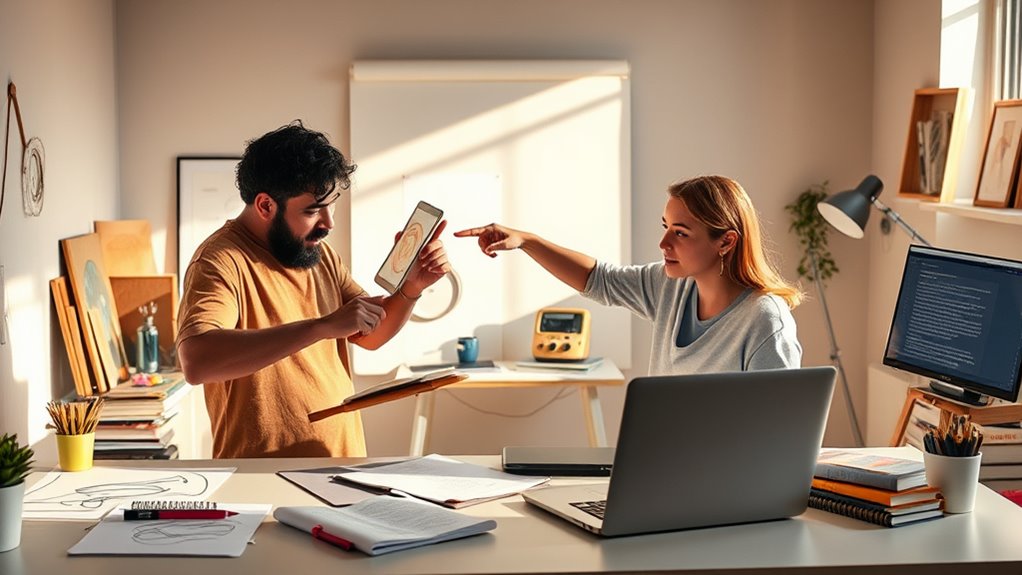
Balancing human creativity and machine assistance requires understanding each other’s strengths and limitations. You leverage AI’s ability to process data, identify patterns, and handle repetitive tasks efficiently. At the same time, your unique skills shine in generating original ideas, making ethical decisions, and understanding social nuances. To optimize collaboration, consider this table:
| Human Strengths | AI Tasks |
|---|---|
| Original ideas, ethics, nuance | Data analysis, drafting, repetition |
| Emotional depth, refinement | Routine, large-scale processing |
| Contextual understanding | Cost-efficient decision-making |
Recent developments in AI capabilities suggest that integrating these tools thoughtfully can significantly enhance creative workflows without undermining the human element. Additionally, understanding the limitations of AI helps in setting realistic expectations and fostering effective teamwork. For example, AI can also assist in creative ideation by providing diverse perspectives that inspire human creators. Recognizing the ethical considerations involved in AI-assisted projects is essential to maintain trust and integrity in creative endeavors. Furthermore, combining AI with human input can lead to more innovative and collaborative outcomes. Incorporating spiritual awareness into the creative process can also deepen the authenticity and emotional impact of the work.
Future Opportunities and Challenges in Creative AI Integration
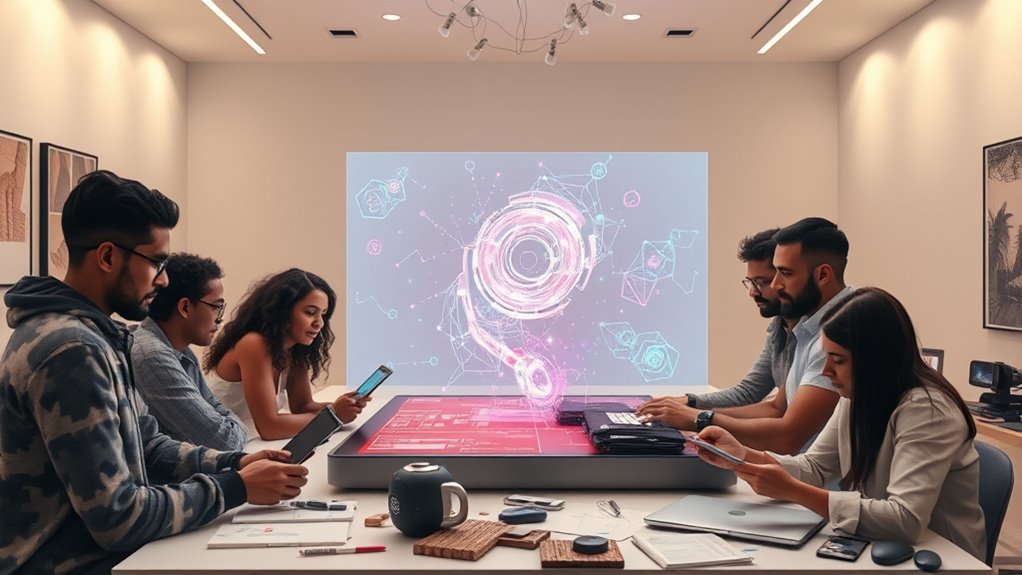
The integration of AI into creative processes opens up a world of new opportunities, but it also introduces significant challenges. You can leverage AI to automate repetitive tasks, freeing up more time for conceptual and artistic exploration. It democratizes creation, making professional-quality work accessible to smaller budgets and wider audiences. Rapid iteration allows you to test and refine ideas quickly, while large-scale personalization helps tailor content to specific audiences. Artistic exploration is expanded through tools like Midjourney, enabling directions that previously took weeks. Technological advancements in AI have led to more sophisticated tools that support complex creative workflows, however, challenges remain, such as the risk of aesthetic standardization, copyright issues, and the environmental impact of energy-intensive models. Addressing ethical considerations and ensuring responsible use will be crucial as these tools become more integrated into creative fields. Strategies for ethical AI use are essential to foster trust and sustainability within the creative community. Furthermore, embracing AI-driven content generation can enhance productivity and inspire new forms of artistic expression. Additionally, the rapid growth of AI-driven content raises questions about authorship and originality, which will require careful navigation as the industry evolves. As awareness of interior design and aesthetics grows, integrating AI tools thoughtfully can help creators develop more personalized and cohesive works. Balancing these opportunities and obstacles will shape the future of creative AI, demanding thoughtful adaptation from artists and writers alike.
Frequently Asked Questions
How Do Artists Ensure AI Tools Do Not Compromise Their Unique Style?
You guarantee AI tools don’t compromise your unique style by curating training data that reflects only your work, maintaining human oversight, and guiding the AI with clear objectives. You customize algorithms to emphasize your signature traits and use AI outputs as inspiration rather than final pieces. By continuously refining these tools and embedding metadata, you protect your artistic identity, ensuring the AI enhances rather than dilutes your distinctive style.
What Ethical Considerations Arise From Ai-Generated Creative Content?
Ever wondered about the ethical concerns with AI-generated content? You must consider privacy risks, like unintentional data leaks, and guarantee you’re complying with data laws. Misinformation, bias, and accountability are also critical—verify outputs and monitor for inaccuracies. Respect intellectual property rights by transparent attribution, and disclose AI use openly. Do you prioritize responsible use? You should, as ethical practices build trust and protect both creators and audiences.
How Can Educators Incorporate AI Training Into Creative Disciplines?
You can incorporate AI training into creative disciplines by providing specialized resources and professional development opportunities for educators. Develop curricula that integrate AI tools meaningfully, showing students how to use them ethically and effectively. Offer ongoing workshops and support to keep educators updated on the latest AI applications. By fostering a collaborative environment, you’ll help students explore new creative possibilities while preparing teachers to confidently guide AI-enhanced projects.
What Are the Best Practices for Collaborative Ai-Human Projects?
You should start by clearly defining roles for both humans and AI, leveraging AI for repetitive tasks and humans for creativity. Maintain open communication through explainable AI and feedback mechanisms, allowing continuous learning. Set decision rights and escalation protocols to guarantee smooth collaboration. Regularly evaluate performance and adapt systems based on feedback, fostering an innovative environment where both human intuition and AI data analysis work together seamlessly.
How Will AI Influence the Future Job Market for Creative Professionals?
You might be surprised to learn that AI-related job postings in creative sectors have increased considerably, signaling major shifts ahead. AI will influence your future job market by automating repetitive tasks, creating new roles, and demanding skills like AI literacy, creativity, and critical thinking. While some jobs may be displaced, you’ll also find opportunities to collaborate with AI tools, expanding your creative potential and adapting to a transforming industry landscape.
Conclusion
As you explore AI’s role in art and writing, remember it’s like a paintbrush in your hand—a tool that amplifies your vision, not replaces it. Just as a brush transforms blank canvas into masterpiece, AI empowers your creativity without overshadowing your unique voice. Embrace these innovations, but stay true to your passion. Together, human ingenuity and technology can craft a future where every artist writes their own story, boldly and authentically.
